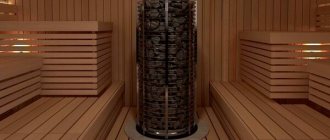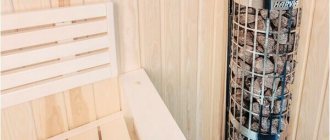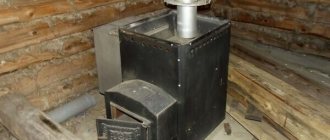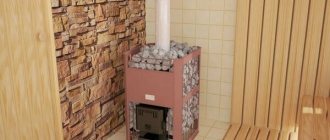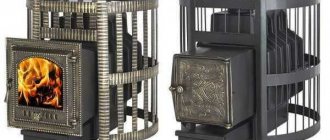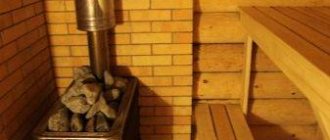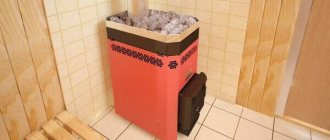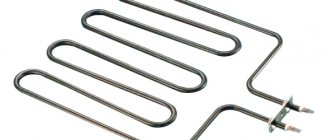The sauna stove is the “heart” of the sauna.
The choice of such devices is varied.
Many people cannot imagine being in a steam room without the aroma of burning wood.
But for comfort and functionality, you should choose a stove that runs on electricity.
It does not create smoke.
Does not require constant cleaning, is lightweight and takes up little space.
On smartphones, you can scroll the table right/left ↔
| Place | Name | Price |
| TOP 5 best electric furnaces for saunas and baths for 220 V | ||
| 1 | Sawo SCANDIA SCA-60NB-Z | Find out the price |
| 2 | Harvia Cilindro PC70E | Find out the price |
| 3 | Sawo ARIES ARI3-60NB-WL-P | Find out the price |
| 4 | Sawo MINI MN-36NB-Z | Find out the price |
| 5 | Sawo MINI COMBI MNC-36NS-Z | Find out the price |
| TOP 5 best electric stoves for saunas and baths at 380 V | ||
| 1 | Sawo ARIES ARI3-60NB-CNR-P | Find out the price |
| 2 | Sawo SCANDIA SCA-60NB-Z | Find out the price |
| 3 | Sawo SAVONIA SAV-90NB-Z | Find out the price |
| 4 | Sawo SCANDIA SCA-80NB-Z | Find out the price |
| 5 | Harvia Cilindro PC70E | Find out the price |
Design features
The main advantages of electric stoves for baths are reliability in operation and a high level of safety. They can be placed in any room, even the smallest. An electric sauna stove does not emit carbon monoxide, a gas dangerous to human life, into the surrounding air, and the heat transfer efficiency is comparable to a stone or iron wood-burning stove.
The main structural parts of an electric sauna stove are:
- Housing made of two layers of metal.
- Heating elements or tubular electric heaters.
- Thermal insulation elements (bath stones).
Such units can be installed either on a horizontal surface or have the ability to be attached to a wall, it all depends on the specific model. There are electric furnaces with two mounting methods at the same time. Typically, such stoves have a control unit. It can be either built-in or portable (in the form of a remote control).
Stones for thermal insulation must be large enough. The outer casing is made of steel elements with a cross-section of up to 4 mm, and a small gap is left between the heater and the casing for ventilation and cooling of the metal.
The top of the stove is usually shielded with sheets of iron to ensure fire safety of the bathhouse or sauna. Heating elements can heat up to temperatures of about 800 degrees. Replacement options include belt plates, which provide a lower temperature but increase the service life of the electric furnace.
TOP 5 best electric stoves for saunas and baths at 380 V
Sawo ARIES ARI3-60NB-CNR-P
An excellent option for those for whom it is important to preserve free space in the steam room . The housing is designed in the likeness of a tower, so that warm air is evenly distributed inside the room. The type of steam produced can be easily adjusted by changing the height of watering the stones.
By watering the top stones you will get intense evaporation, while the bottom stones will produce light steam of moderate intensity..
The manufacturing process of the device complies with all European standards. Only high quality materials are used that can withstand the harsh conditions in the steam room.
The location of the heating elements is designed so that they are in maximum contact with the surface of the stones, which increases the degree and speed of heating . There is a built-in control panel.
Characteristics:
- power - 6 kW;
- min. room volume - 5 m3;
- Max. room volume - 8 m3;
- maximum weight of stones - 65 kg;
- dimensions - 33.5*33.5*100 cm;
Advantages:
- affordable cost level;
- high quality;
- durability;
- suitable for a standard size bath;
- miniature.
Flaws:
- requires loading a large number of stones for effective heating.
Sawo SCANDIA SCA-60NB-Z
For steam rooms with volumes from 5 to 9 cubic meters, the installation of this model can be considered a priority . The combination of two types of metal to construct the heater allows you to achieve the perfect balance between the attractiveness of stainless steel and the reliability of galvanized steel.
The volume of the stone being laid warms up the air in a short time and allows you to obtain comfortable finely dispersed steam.
The oven is equipped with a built-in timer and temperature level regulator. The handles on the control panel are made of heat-resistant material with low thermal conductivity, and therefore do not heat up. The device is located on a suspension.
Characteristics:
- power - 6 kW;
- built-in remote control;
- room volume from 5 to 9 m3;
- maximum weight of stones - 22 kg;
- dimensions - 51.5*29*45 cm.
Advantages:
- reliability;
- nice design;
- fast heating;
- safety.
Flaws:
- No.
Sawo SAVONIA SAV-90NB-Z
An electric furnace for lovers of extremely high temperatures in a steam room, sauna or bathhouse . The body allows you to accommodate a significant volume of stones to create high quality steam. The materials used in production are not afraid of high humidity and temperature.
The legs of the device are height adjustable and increase safety of operation..
The high quality of the electric heater, high power and the presence of additional options allow for regular, long-term use, which is important when organizing a sauna as a business. It is equipped with a built-in control panel.
Characteristics:
- power - 9 kW;
- min. sauna volume - 8 m3;
- Max. sauna volume - 14 m3;
- maximum weight of stones - 50 kg;
- dimensions - 50*41*65.5 cm.
Advantages:
- excellent build quality;
- simple and intuitive controls;
- high performance of the device;
- compactness combined with power.
Flaws:
- not suitable for small spaces.
Sawo SCANDIA SCA-80NB-Z
A miniature stove for an average bath or sauna with simple and intuitive controls at an affordable price . Made from a combination of stainless and galvanized steel, guaranteeing high reliability.
The heating elements are sealed from moisture penetration, so you can pour water directly on top of the stones to regulate the amount of steam without fear of damaging the device.
The power level and operating time are set from the remote control.
Characteristics:
- power - 8 kW;
- min. room volume - 7 m3;
- Max. room volume - 13 m3;
- maximum weight of stones - 22 kg;
- dimensions - 51.5*29*52 cm.
Advantages:
- compact;
- powerful;
- inexpensive;
- economical;
- roomy.
Flaws:
- No.
Harvia Cilindro PC70E
The model is versatile and produces both dry and wet steam . Takes up little free space. Equipped with a built-in control panel.
Holds a large number of stones and has a sleek, minimalist design. It will easily fit into modern interior types and into a classic bathhouse.
Characteristics:
- power - 6.8 kW;
- min. volume - 6 m3;
- Max. volume - 10 m3;
- maximum weight of stones - 80 kg;
- dimensions - 32*32*93 cm.
Advantages:
- appearance;
- metal quality;
- control.
Flaws:
- No.
Basic operating principles
After applying voltage to the heating element, it begins to gradually heat up. This heat is transferred to coolants in the form of special stones. They accumulate heat and then release it either to the metal body (for closed-type ovens) or directly into the steam room (for open-type ovens).
For a classic Russian bath, the second option is more suitable. There are intermediate models equipped with a lid. Such electric sauna stoves can be opened at any time, increasing the convection of heated air from the heater.
Material of manufacture
Electric heaters are made from the following materials.
- Cast iron stoves. They have a lot of weight, but retain heat well.
- Enameled steel. A little in demand option.
- Stainless steel stoves. The most comfortable and current models, which are famous for their durability.
Advantages and disadvantages
The positive aspects of electric sauna stoves are:
- The combination of rapid heating of a steam room and the ability to maintain the required temperature for a long time.
- Small sizes.
- Possibility of self-installation of such stoves. Unlike gas sauna stoves, permission from the gas service for installation is not required.
- There is no need to store fuel by placing it in the bathhouse; the stoves operate from a regular electrical network of 220 or 380 volts.
- An electric stove for a Russian bath does not require a smoke exhaust duct, which simplifies installation.
- It does not require cleaning from soot or periodic maintenance.
- Easy adjustment of the required oven temperature.
- Thanks to automation, unwanted overheating is eliminated.
- Such a stove does not emit carbon dioxide, it is safe for human life.
- The electric sauna stove has good heat protection, minimizing the possibility of fire in the wooden elements of the steam room.
At the same time, it is worth highlighting the disadvantages of such electrical units:
- The high cost of its maintenance, electrical energy is a fairly expensive type of fuel, and such stoves are very energy-intensive installations
- Often, powerful electric furnaces do not have enough electrical wiring life, which is designed for a lower consumed load.
- The heat generation of electric stoves is lower than that of gas or wood heating sauna stoves.
A heating element
To complete the equipment, special heating elements are most often used; they can be of a strip type or a combined type. The cost of such a device is not too high and it can be replaced at any time if a breakdown occurs.
It will not be possible to operate such elements for a long time, this is due to the fact that they are often subjected to mechanical stress. When purchasing an item, it would be advisable to choose models with high-quality alloy in this element.
What types of electric furnaces are there?
Weight of loaded stones
Depending on the purpose of electric sauna stoves and the weight of the stones that are placed in them, all electric stoves can be divided into 3 groups:
- Models with heaters for 20 – 40 kg.
- Models with heaters for 60 – 120 kg.
- Models for commercial use.
Stoves with a volume of stones up to 40 kg are perfect for small private steam rooms designed for 4 - 5 people. They are quite cheap, practical and easy to install. Their advantage is the quick heating time of the steam room, it will be no more than half an hour. An electric sauna stove like this can and should be watered frequently, and small portions of water will have to be added to it.
Electric furnaces with a weight of loaded stones ranging from 60 to 120 kg are more serious installations that are suitable for both large private bathhouses and small commercial bathhouses.
Prices for electric stoves for a bath of this type are 1.5 - 2 times higher than for stoves with a smaller volume of stone fraction.
Complete heating of such a unit occurs after 1.5 - 2 hours; such a stove gives off heat for a long time and better maintains a stable temperature regime. Adding water can be done without restrictions on the amount and time of adding.
Commercial models hold 200–280 kg of stones and are used in public steam rooms. They are able to work both in sauna and Russian classical bath modes. Such stoves are designed for steam rooms with a volume of several tens of cubic meters. Their price can be 40,000 rubles and more.
Bath electric furnace body type
There are two types of bodies for electric sauna stoves - closed and open type.
- The electric stove for an open-type Russian bath is a classic sauna stove, the stones in it are on the surface. The main disadvantage of such devices is that they cool down over time.
- Closed models of electric furnaces received the nickname “thermos” because of their design. They are made in the form of a round flask with a lid that opens on top. The stones themselves are located inside and are heated by heating elements built into the walls of the body. The big advantage of such devices is that the lid prevents the stones from cooling, and the steam is finely dispersed. Thanks to these properties, this is an excellent option for a classic Russian steam room.
Bath stones
The number of stones placed in the device depends on the size of the electric bath. The stones need to be laid tightly, but it is important to leave space for air movement.
For stoves, you can only use special stones that are not afraid of heat. Under no circumstances should they emit harmful substances or crack during heating.
The structure of the stones should be uneven; smooth stones should not be used. It is important to replace them promptly and remove cracked or chipped stones. It is necessary to carry out a refurbishment once every few months; jadeite, diabase, soapstone, and so on are ideal as bath stones.
Criterias of choice
The modern market offers many options for such units. The question of how to choose an electric stove for a bath is not so simple. The main selection criteria should be taken into account, these include:
- Preliminary calculation of the volume of the steam room.
- Furnace controls.
- Type of heating circuit.
- Design issues.
- Availability of a certificate of product conformity to Russian standards.
There is a simple relationship between the volume of the steam room and the power that the stove installed in it should produce. For 1 cubic meter of steam room there should be 1 kW of power. This calculation is approximate, but with its help the buyer can determine the choice of electric stove of the required performance.
The control panel for a sauna stove can be either remote (remote), installed in another room (in the dressing room), or built into the body of the electric stove itself.
Heating elements for electric sauna stoves can be of three types:
- Tubular (heating elements), made in the form of a tape. Heating elements are capable of heating air to very high temperatures, but they have a serious drawback - they are fragile and their service life is short, and the heating process is slow. Reliable stainless steel heating elements are very expensive. Tape elements are more profitable, heat up faster and are more reliable than heating elements.
- Combined type. The combined type of heaters is the most expensive, but it is the one that ensures the fastest and highest quality heating of the air in the steam room.
Electric sauna stoves, as well as wood-burning ones, can be made in any style. They can be located in the middle of the room, stand in a corner, or hang on the wall.
Additionally, you can purchase inlays made of soapstone or soapstone; this will not only decorate the stove, but will also provide additional protection from the effects of high temperatures on the walls of the steam room. Such stone panels retain heat well and can be an excellent complement to the stones inside the stove.
When choosing a stove, you should pay attention to the availability of a valid safety certificate for it and the materials from which it is made.
Help with measurements
Today, there are programs for calculating the area of a room and identifying the required power of the device. You can use them or ask for help from specialists in this field. Don’t forget about windows; if they are in the room, they will definitely affect the heat exchange.
As a result of heating, much more heat will be needed than with solid walls, since the air will circulate faster. These characteristics are among the most important for achieving positive results and comfortable rest, so they should not be neglected.
Popular models
- Polytechnic Cristina Classic. The model is suitable for a steam room with a volume of 10 - 15 cubic meters. meters, its power is 10 kW, the weight of stones is 25 kg, the price is 16,800 rubles.
- Stream Gross 1 Heat boost. The stove is suitable for steam rooms with a volume of 8 - 14 cubic meters. meters, its power is 10 kW, the weight of the laid stones is 31.7 kg, the cost is 36,600 rubles.
- Narvi NM600. Finnish product, recommended steam room volume 6 - 9 cubic meters. meters, furnace power 6 kW, weight of stones 30 - 40 kg, cost - 13,200 rubles.
- Helo Himalaya 105DE. An electric furnace of Finnish-German production with a power of 10.5 kW is capable of heating a steam room with a volume of 9 - 15 cubic meters. meters, the weight of the stones being laid is 100 kg, it costs 50,500 rubles.
- Harvia Cillindro PC70E Steel. Stove from Finland for steam rooms with a volume of 6 - 10 cubic meters. meters, power 6.9 kW, weight of laid stones 90 kg, cost - 17,400 rubles.
- Tylo Combi Compact RC3. Swedish low-power stove of 3 kW, suitable for rooms with a volume of 1.5 - 4.5 cubic meters. meters, the weight of the stones is only 7 kg, the price is 67,000 rubles.
- Tylo Expression 10. A more powerful electric sauna stove with a capacity of 10 kW, for steam rooms with a volume of 10 - 18 cubic meters. meters. It contains 12 kg of stones, and the price is 97,000 rubles.
- Tylo SD 20. Powerful 20 kW device, for rooms with a volume of 22 - 43 cubic meters. meters, the weight of the stones being laid is 32 kg, the cost is 91,000 rubles.
- Thermofor Primavolta. This Russian-made electric sauna stove can heat a room of up to 5 cubic meters. meters, its maximum power is 9 kW. It holds 50 kg of stone and costs 12,000 rubles.
- Dushka EKM-18 NMT. Russian powerful 18 kW stove for large steam rooms of 21 - 30 cubic meters. meters. You can put 65 kg of stone in it, the price is only 12,300 rubles.
Power supply type: 220 or 380 volts
For a small bathhouse, an electric heater with a 220 V power supply is suitable. You can connect and install such a stove yourself. Of course, it is better to call an electrician to check the wiring.
More powerful models are designed for a voltage of 380 V. It is better to call a specialist to connect them. Proper grounding is especially important here. There should be no phase imbalance, voltage drop, etc.
There are also stoves that can operate on both types of networks. If possible, it is better to connect them to 380 V.
Rules for installing electric sauna stoves
Requirements SNiP 41-01-2003
This document regulates the basic rules for placing electric furnaces from a fire safety point of view:
- The stove must be installed in a corner closer to the entrance, however, subject to the requirements of SNiP, installation in the center of the room is also allowed.
- The floor where the stove is installed is covered with non-combustible materials.
- The distance between the wall and the furnace body must be at least 0.5 meters in the absence of a screen. If such protection is installed, it is allowed to place the electric oven closer.
- There should be a hole in the area of the heater for fresh ventilation.
- The furnace body must be protected by a fence located at a distance of at least 70 cm.
.
How to install the housing and controls?
The first step is to wash and dry the stones, place them and turn on the stove. When connecting an empty stove, the heating elements will burn out. When installing the control panel, the following requirements must be met:
- The external remote control is installed in a room where there are no elevated temperatures.
- The wiring is done in advance.
- The power that the electrical panel and wires can withstand must not be lower than the power of the electric furnace.
- The presence of an RCD is required.
- In order to avoid contact between wires and heated walls, they are laid in a special bus made of fireproof material.
Installation of sensors and grounding
It is recommended to use only cables made of heat-resistant material. The presence of twists is excluded; all wire sections must be intact. Sensors are usually mounted above the door, heater and steam benches.
GOST 12.1.030-81 requirements and electrical wiring cross-section
According to GOST 12.1.030-81, the electrical circuit must be grounded directly or grounded through the shield. As mentioned above, the power that the wiring can withstand must be higher than the power of the furnace itself. The selection of conductor cross-sections is made according to special tables.
.
Sauna ventilation
Good ventilation in the sauna also plays an important role when connecting the stove. It will provide sufficient oxygen levels, maintain freshness and retain steam. If you organize it correctly, you will save energy, especially during warm-up.
The photo shows the optimal ventilation scheme with an exhaust hood
Typically, ventilation in a heater can be forced or natural.
- With forced ventilation, it is necessary to ensure air supply through the incoming air valve above the heater, at a height of more than 50 cm. In the diagram, this zone is shown as a hatched area with the letter “A”. This type of ventilation is recommended.
- The exhaust duct should be installed as far and low as possible relative to the heater.
Advice! If the exhaust valve cannot be made so low, you can leave a gap of 10-15 cm under the door. The exhaust cold air will go into the adjacent room and then into the ventilation system.
- If natural air circulation is used, the air should come from the area below or next to the heater (shaded area "B" in the diagram). In this case, the hood is installed as far as possible from the heater and at least 1 meter higher relative to the supply. Usually the hood is made under the shelf, or a gap is simply left under the door.
Forced and natural ventilation
Nuances of operation
The electric furnace does not require particularly careful maintenance, but you still need to follow the basic rules of its operation. The main point is compliance with the rules of electrical safety and ventilation of steam rooms.
Do not allow water to come into contact with wires or electrical heating parts of the oven. In the steam room, you should always ensure the minimum permissible air circulation. To avoid rapid burnout of the heating elements, the load must be applied smoothly immediately after starting the furnace.
Types of metals
The body and internal components can be made of various types of materials; cast iron specimens are durable and have high heat transfer, but are quite bulky and heavy.
Stainless steel will be lighter and less massive and has a number of advantages, including an attractive appearance. Enameled steel is used in rare cases, but some people use such devices to equip steam rooms.
Final points
A sauna with an electric stove is a powerful consumer of electricity. When choosing, it will be very important to pay attention to the electricity consumption of the stove; this will save significant amounts, even if the stove is quite expensive.
From an aesthetic point of view, foreign models are superior to their Russian counterparts, but they are also more expensive. Specific options should be considered based on financial capabilities when purchasing, as well as taking into account the volume of the steam room and the power that the electrical wiring and transformer can withstand.
Power to area ratio
The parameters of some manufacturers may differ in quality and heating strength; these aspects should not be left to chance. It is necessary to take into account the existing room or adjust it to the selected stove.
You need to calculate the dimensions of the room in advance and build on them; the power will depend on the existing insulation of the walls and the height of the ceilings. It is not necessary to give preference to the exact number, but the approximate parameters should be equal.
Reviews
Of course, we are all tired of advertising and want information that comes directly from users. But it has long been the subject of falsification, so let’s proceed from common sense: in general, reviews of the electric heater will be positive from those who received exactly what they wanted - either a sauna stove, or that rare variety that allows you to arrange a sauna “in Russians." And if you want more detailed information, take a look at the articles that are devoted to specific models, where reviews will concern both real advantages and real disadvantages.
Problem: the electric heater is humming
We can assume that the reason your electric heater is humming is due to an increase in air draft (this happens in chimneys). All electric furnaces have holes at the bottom for the intake of cold air, which flows to the heated stones, and from there goes upward with force. The upward movement of lighter hot air creates draft. It may be more or less, depending on the temperature difference .
Of course, the cause of the hum may also be a malfunction of the device. In this case, you should contact a specialist or service center.
Recommendations for installing an electric stove
A small electric furnace with a power of 4.5 kW is installed in a small steam room. Before starting work in the steam room, it is necessary to remove the wiring and provide fresh ventilation.
Ventilation needs to be taken care of in advance.
To carry out the work you need the simplest tool and some materials. You need to stock up on sheets for creating a screen and self-tapping screws, for installation of which you will need a screwdriver. To cut holes in the screen plates, you will have to use a jigsaw. To connect the cable to the terminals, you need a Phillips screwdriver.
Step 1 . Screen installation. It can be made of metal sheets (stainless steel is used), which is most often used. However, other fireproof materials can be used. For example, Flamma fiber cement sheets, which have excellent fire resistance and safety. To fix the plates, you need to drill holes. After this, you should fix one part of the screen with self-tapping screws through ceramic bushings (6 pieces per sheet are enough). This is necessary to create an air gap between the steam room wall and the fiber cement.
Screen installation
The second sheet of screen, on which the stove will be suspended, is attached directly to the wall through a layer of foil-coated basalt cardboard. This heat insulator is attached using a stapler.
First, you need to cut a hole in the screen element for the supply pipe. You also need to provide a wiring outlet. After installing the sheets, the supply ventilation grille is attached.
Finished screen
What else is good about fiber cement boards: they are cheaper than stainless steel sheets and splash marks are not visible on them.
Step 2 . Electricity supply. To connect three phases, a five-core cable is required. It is inserted into the device through a rubber gasket and securely fixed. After this, all the conductors are attached to the corresponding terminals: grounding, zero and three phases.
The cores are attached to the terminals
The electric furnace cover is installed.
Step 2 . Stove mounting. The electrical appliance must be placed at least 15 cm from the floor. You will need 6x80 mm self-tapping screws. Since the weight of the unit can be significant, it is recommended to additionally install a mortgage in the wall at the location of the fasteners (under the cladding). Markings are applied for installing hardware. Two self-tapping screws are screwed in, on which the stove will hang.
Self-tapping screws are tightened
The heater is suspended on a mount.
Hanging stove
Step 4 . Preparing for work. Carefully, trying not to damage the heating elements, the stones are laid. They must be washed and dried. It is recommended to choose narrow stones that fit freely between the spirals of the heating element. They are not laid close to each other; there should be a small distance between them so that hot air can escape freely.
Laying stones
If you do come across large stones, it is better to lay them on top. The oven is ready for use.

